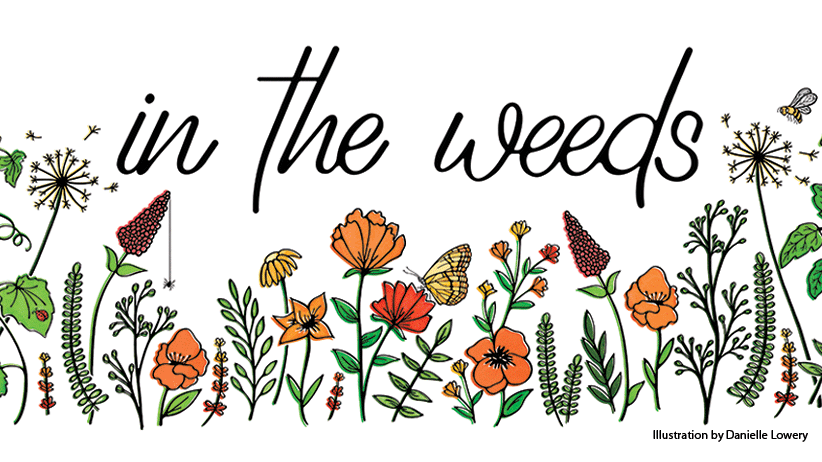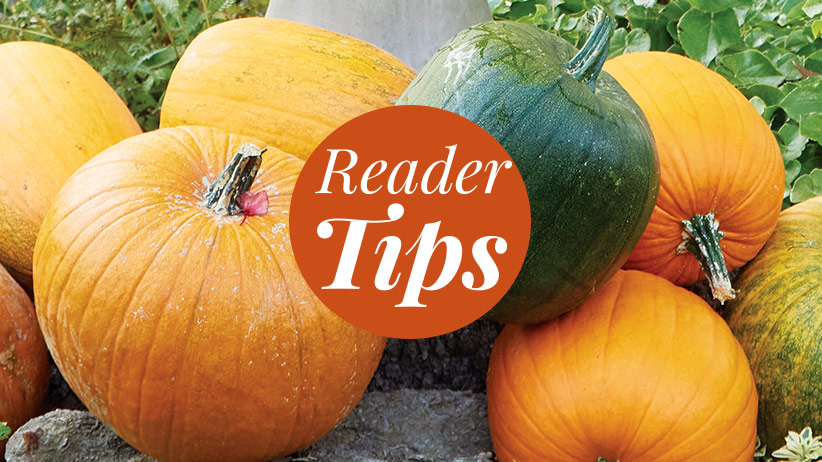Introducing our 2024 Reader Garden Award Winners!
With a love for trees and a knack for DIY projects, Maine’s Candy and Don Gagnon have created a garden that has appeal throughout the seasons. And they have a lot of stories to tell about its development. Congratulations to Garden Gate’s 2024 Reader Garden Award Winners!
It started with the shade trees and flowering trees
Candy and Don began gardening more than 40 years ago when they built their first home. When the Gagnons built their current house 20 years ago, they had to leave an established garden and start over. The new 2-acre property needed to be mostly cleared for construction. But they were careful to leave as many of the original oaks (Quercus spp.), maples (Acer spp. and hybrids) and Canadian hemlocks (Tsuga canadensis) as they could. They’ve made these original trees and lots of new flowering and shade trees the centerpiece of their garden efforts since then.

Beautiful additions to the garden
Over the years, they’ve added a collection of hardy magnolias (Magnolia spp. and hybrids), including ‘Butterflies’, ‘Jane’ and ‘Leonard Messel’, many dwarf conifers and several dogwoods (Cornus spp. and hybrids). At least one tree anchors most of the garden’s beds. Trees, shrubs, perennials and annuals combine to offer color and interest year-round. Don says, “I can’t pick a favorite time of year, because there’s always something to look at here.”
Wide garden paths make maintenance easier
Lawn paths wind through a series of stone-edged island beds in the area around the house. A crushed-granite maintenance path is wide enough for a lawn tractor and cart. It encircles the property, which also includes a large cut-flower and vegetable bed and two ponds with waterfalls and streams.
You Might Also Like:
Meet the 2023 Garden Gate Reader Garden Award Winners!
2022 Garden Gate Reader Garden Award Winners
Tour the 2021 Garden Gate Reader Garden Award Winner
Meet Our Inaugural 2020 Garden Gate Reader Garden Award Winner

Dealing with tree problems
It’s true that woody plants, such as flowering trees and conifers, often require less maintenance than perennials and annuals, but they aren’t without their challenges. Don and Candy watch vigilantly for pests so they can deal with them quickly. For example, as soon as they noticed that a branch on their favorite Swiss stone pine (Pinus cembra) was turning brown, they suspected a pine borer. Don got out the ladder and pruners and went to work. Candy says, “You have to be sure to find the larva inside the stem, and then keep cutting until you are back to healthy wood.”
Deer also seem to like nibbling on rhododendron (Rhododendron spp. and hybrids) foliage and other plants around the property’s perimeter, especially in winter when there is less to eat elsewhere. So the couple remains watchful year-round and install cages made of fencing around vulnerable plants. They’ve noticed a direct correlation between their affection for a plant and a deer’s taste for it: “Anything you like more, the deer do too!” Candy jokes.
Choose distinctive trees for your garden
Meet few of the Gagnons' favorite specimens. Some are flowering trees. Others have beautiful foliage or form. All boast multiseason interest.
- ‘Autumn Moon’ fullmoon maple (Acer shirasawanum)
New foliage opens chartreuse and orange and fades to gold-orange for summer; vivid fall color; full sun to part shade; 8 to 15 ft. tall, 6 to 15 ft. wide; cold hardy in USDA zones 5 to 8 - Golden Spirit smokebush (Cotinus coggygria)
Foliage emerges chartreuse in spring, turns gold by summer and orange-red by fall; airy pink summer flowers; full to part sun; 8 to 15 ft. tall and wide; cold hardy in USDA zones 4 to 8 - ‘Purpurea’ Purple catalpa (Catalpa x erubescens)
Large leaves emerge purple and turn dark green; large showy flower panicles emerge in late spring; full sun to part shade; 40 to 50 ft. tall and wide; cold hardy in USDA zones 5 to 8 - Swiss stone pine (Pinus cembra)
Soft, slightly curly blue-green needles and green-purple cones; full sun; 30 to 40 ft. tall, 15 to 25 ft. wide; cold hardy in USDA zones 4 to 7
You Might Also Like:
7 Ways to Use Conifers in the Garden
Designing with Japanese Maples
Conifer Q&A

Divide & propagate plants to fill a garden
It takes a lot of plants to fill a 2-acre garden. One economical way to do that is by propagating ones you already have. Many perennials reseed or spread by the roots. The Gagnons often let plants grow where they will, and enjoy the big sweeps of color in midsummer. In spring, blue love-in-a-mist (Nigella damascena) flowers float their way through the garden.
Of course, not every plant reseeds where they’d like it to grow. And Don has a hard time bringing himself to pull and throw away plants, so he digs seedlings and replants them in a designated nursery bed where they can get established. When a visitor admires a particular plant in the garden, he or she often leaves with one or two of them from this plant nursery. And when Don and Candy come home from the garden center with a new prize tree, they can easily start a bed around it with perennials from their own garden.

Trees sometimes reseed
Sometimes this propagation extends to trees and shrubs too. Don and Candy were surprised to see that the large Twisty Baby® black locust tree (Robinia pseudoacacia) in the front yard came true, or produced seedlings with the unique contorted form of their parent, so of course they saved some and incorporated those seedlings elsewhere in the garden.
Candy does plenty of intentional propagation as well, by taking cuttings of everything from coleus (Plectranthus scutellarioides) to magnolias. And of course they’ve divided plenty of perennials, such as daylilies (Hemerocallis spp. and hybrids) and ornamental grasses, over the years, although they’re running out of room for more beds and don’t divide as much as they used to. Candy’s mother’s maidenhair ferns (Adiantum spp.) have grown in number and found homes in many shady spots throughout the garden too.
Utilize garden resources
As you can tell, the Gagnons utilize almost everything that they find in their garden. Of course they compost. But they also built fieldstone walls, lined their two ponds and waterfalls and edged every island garden with edging stones found on the property.
Building garden edging with stones
When edging garden beds, Don looks for the flattest stones for the parts that border lawn so he can run the mower close and eliminate extra trimming. He’s even dismantled old stone walls throughout the property for use in other projects, including the new wall and “gnome home” with built-in storage.
Even the lumber from trees that require removal finds a second life in this garden: They have the wood milled and save the lumber for future woodworking projects.

Creative upcycling projects
In addition to gardening, Don and Candy both have many other creative outlets: For Don, it’s woodworking and home building, and for Candy, it’s art and quilting. She’s had fun making garden ornaments of items most of us would consider trash and enjoys quizzing people on whether they recognize the source material. The flower above is made from fertilizer scoops: She uses a Skilsaw to cut pine into the appropriate shape, then glues the items onto it before spray-painting, sometimes in several colors and layers to create dimension.
You Might Also Like:
Watch Our Garden Project Videos on YouTube
Upcycled Hanging Planter
How to Install Brick Edging

Saving tender plants over winter for a more colorful summer
Tropical plants add summer contrast and color in this multifaceted garden. With Don and Candy’s love for propagation, you won’t be surprised to learn that this busy couple saves many tender plants over winter. For example, Don’s brother Moe and sister-in-law Sue shared a few lily of the Nile plants (Agapanthus hybrids) acquired in Florida several years ago, and now they have the collection you see above. (And they’ve given several away too!)
Candy says that lily of the Nile blooms better when it’s root bound, so they don’t divide until they absolutely have to. Once freezing temps arrive outdoors, they move the pots into the attached insulated garage, where temperatures don’t dip below about 37 degrees F through the winter. It’s just warm enough to keep these USDA zone 8 plants from freezing.
Overwintering containers
At the end of the growing season about 10 years ago she decided to try to save a summer container in the garage over the winter and discovered that the spike plant (Dracaena indivisa) survived beautifully. So she kept growing it, and now it’s the centerpiece of the container grouping above.
Some plants do better in another cool spot behind their basement stairs: Every year the elephant ear collection (Colocasia esculenta) expands as bulbs multiply over the summer when planted in containers and tucked into beds. Candy digs, cleans and stores them in a box of sawdust. In March she lays the bulbs on the sunroom floor and waits until she sees sprouts to pot them up.

Seed-starting saves money
In spring, Candy’s seed-starting racks are full of annuals. Last summer, her Profusion™ Orange zinnias (Zinnia hybrid) made a splash in a mixed planting while other varieties were cut for beautiful bouquets. The petunias (Petunia hybrids) filled containers on the deck and around the entry. She starts these seeds in trays in the sunroom and on lighted shelves in front of the deck doors. When the house gets too full of plants in April, she starts moving them to the unheated greenhouse, where they’re easy to take care of until she can safely plant outdoors. In her zone 5 garden, Candy says, “I usually consider the last full moon in May as the frost date.”
As she has time, Candy gradually hardens seedlings off over a few days in shady spots before she puts them in their permanent homes. She babies them until they can get well established in the garden: “I hate to lose something I’ve grown from seed,” she says.
Candy's petunia seed-starting tips
Growing a lot of plants of the same variety is a great way to make a big impact in your garden, but it can get expensive at the garden center. For economy, Candy starts most of her petunias from seed every spring. Last spring she grew flats of Shock Wave® Purple Tie Dye and Shock Wave® Coral Crush. Here are a few of her tips:
- Don’t start too early. Otherwise plants get leggy and crowded indoors. She pays attention to the directions on the seed packets and times her planting accordingly.
- She likes how clean it is to start seeds in straight vermiculite. When seedlings have four to six true leaves, move them up into potting mix and recycled pots and packs.
- Once you’ve planted your petunias outdoors, feed them two times each week. Use a bloom booster water-soluble fertilizer to keep them flowering.

Dahlia growing advice
At the back of the garden you’ll find the cut-flower bed featuring about 140 dahlias (Dahlia hybrids). Before they plant the tubers directly in the garden in spring, they make a single pass with the mini tiller down each row to loosen the soil in the mounds. Landscape fabric between the rows keeps the weeds down and remains in place all year. A rebar stake with a label tied to it marks the location of each tuber and provides sturdy support if the plants need it later. Candy has tried starting tubers in pots early but discovered no advantage in it: They didn’t bloom much earlier than those planted directly in the ground.
You Might Also Like:
How to Grow Dahlias
10 Best Plants for a Cut Flower Garden
Find the Right Dahlia for Your Garden

Summer dahlia maintenance
Throughout the summer, a drip irrigation line with an emitter at the base of each dahlia plant makes it easy to deliver the moisture they need to develop the best blooms. The Gagnons are also able to leave these drip lines out year-round, as long as they drain them before winter.
Storing dahlia tubers over winter
After frost has killed the foliage, the couple chooses a time when there’s no rain expected to prepare the tubers for winter storage. They dig them, wash off the soil and let them dry on the driveway for a day. Then they divide large clumps into more manageable sections, label each one and drop it into a plastic newspaper bag with a few holes poked in it. These bags go into boxes on shelves in the attached garage for the winter. In spring, when they start to see new growth on a tuber, they know that it will likely be successful.
Gardening never gets old!
A garden can be a lot of work. But this energetic, and now award-winning, couple takes it all in stride, choosing to spend as much free time as possible on projects and testing new plants and growing methods. During the growing season, they end every day’s early-morning walk with a pass through the garden before they start their work for the day. In summer, they notice how the magnolias are setting buds for next spring’s blooms, check on plants they’ve treated for pests, and decide which dahlias might need staking because of recent winds. Gardening never gets old!
Enter your garden for a chance to win next year's Reader Garden award!
Think your garden could be a contender in the Garden Gate Reader Garden Awards? Learn how to submit images and information about your garden to be considered for next year's award in our entry guidelines.















